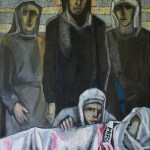
Conducted by the artist Karim Dabbah
Published in Al-Tali’a Newspaper, June 22, 1978
I was born in Haifa in 1942, where I completed my elementary and secondary education. In 1964, I traveled to East Germany to study art and enrolled at the Dresden Academy of Fine Arts. In 1971, I received a master’s degree in mural art.
I am married and have two sons.
There are various circumstances—among them economic reasons—that lead me to believe that Arab artists in Israel have not yet formed a distinct and defined visual arts movement, even though some of these artists have studied or are continuing their studies in Europe. But over time, a unique school or artistic direction will emerge among Arab artists in Israel. The independent identity of the people will be the inspiration and driving force for these artists.
The most important work I have created is the Land Day Monument in Sakhnin. It is made of molten aluminum, with a height of approximately 230 cm and a width of 450 cm. The monument was created in collaboration with the progressive Israeli artist Knispel, and with the help of the people of Sakhnin, many blacksmiths, and others.
I believe that the time has come for art to leave the confines of the gallery and the walls of the elite who can afford to buy and own it. It would be more beneficial to place monuments, sculptures, and murals in public squares, bus and train stations, and public buildings.
I hope that the experience of the “Land Day Monument” will be repeated. It expresses the history and suffering of this people. Our people have faced painful experiences, but it is possible to extract something positive from this sorrow—something that transcends national interests toward what is human and universal.
At the volunteer work camp in Nazareth, we carried out aesthetic projects that had artistic and visual dimensions. The Nazareth experience proved that people can appreciate visual art just as they appreciate poetry. In Nazareth, we strove to give the walls of the streets a sense of cultural and human belonging. This work can be the beginning of further, more thoughtful and planned stages in Nazareth and in other towns and villages. The attempt is a call to encourage municipalities to allocate special budgets for beautifying cities, squares, public spaces, and streets.
As for the visual arts movement in the West Bank and Gaza, it can be said that it has started in a positive and appropriate way. It is possible to face challenges with a high level of cultural sophistication to overcome them. I also believe it is necessary to unify the voice of artists, and I think it is important to benefit from progressive trends within the visual arts movement, as this strengthens the core of the movement and gives it new blood.




















